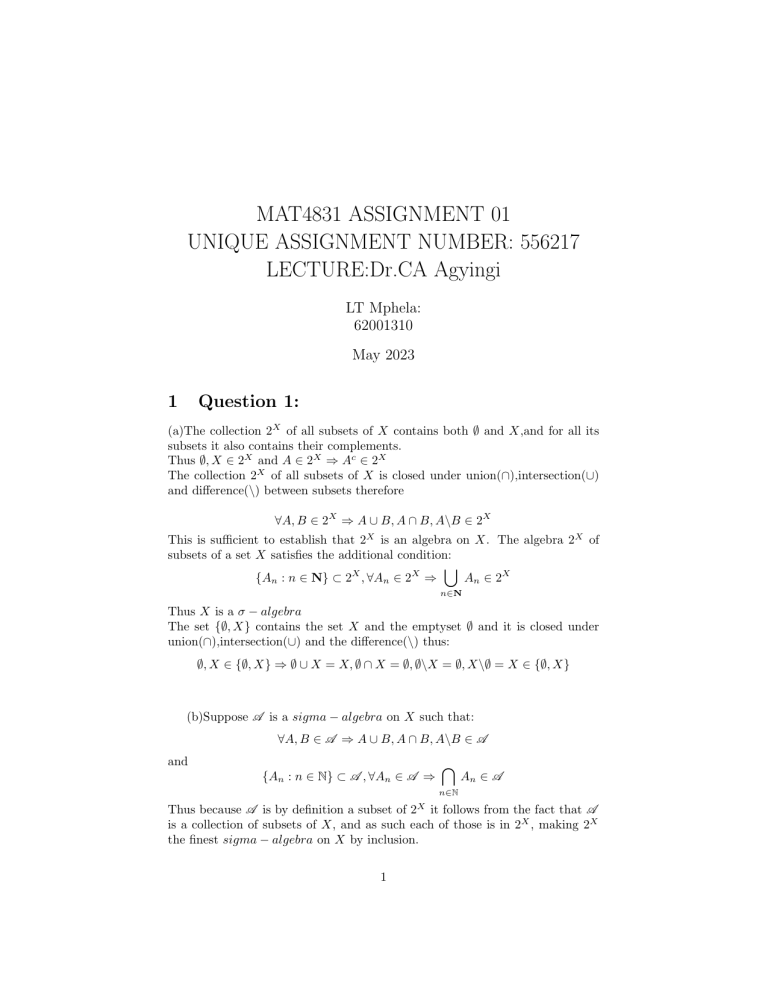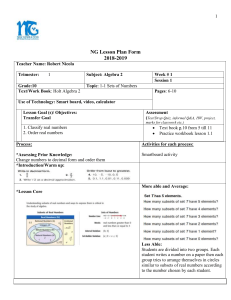
MAT4831 ASSIGNMENT 01
UNIQUE ASSIGNMENT NUMBER: 556217
LECTURE:Dr.CA Agyingi
LT Mphela:
62001310
May 2023
1
Question 1:
(a)The collection 2X of all subsets of X contains both ∅ and X,and for all its
subsets it also contains their complements.
Thus ∅, X ∈ 2X and A ∈ 2X ⇒ Ac ∈ 2X
The collection 2X of all subsets of X is closed under union(∩),intersection(∪)
and difference(\) between subsets therefore
∀A, B ∈ 2X ⇒ A ∪ B, A ∩ B, A\B ∈ 2X
This is sufficient to establish that 2X is an algebra on X. The algebra 2X of
subsets of a set X satisfies the additional condition:
[
{An : n ∈ N} ⊂ 2X , ∀An ∈ 2X ⇒
An ∈ 2X
n∈N
Thus X is a σ − algebra
The set {∅, X} contains the set X and the emptyset ∅ and it is closed under
union(∩),intersection(∪) and the difference(\) thus:
∅, X ∈ {∅, X} ⇒ ∅ ∪ X = X, ∅ ∩ X = ∅, ∅\X = ∅, X\∅ = X ∈ {∅, X}
(b)Suppose A is a sigma − algebra on X such that:
∀A, B ∈ A ⇒ A ∪ B, A ∩ B, A\B ∈ A
and
{An : n ∈ N} ⊂ A , ∀An ∈ A ⇒
\
An ∈ A
n∈N
Thus because A is by definition a subset of 2X it follows from the fact that A
is a collection of subsets of X, and as such each of those is in 2X , making 2X
the finest sigma − algebra on X by inclusion.
1
2
Question 2:
(a)Since measures are monotonic, the following proposition follows:
For the measure space defined above, and let A and B be subsets of X that
belong to A and satisfy A ⊂ B.Then µ(A) ≤ µ(B) and µ(B −A) = µ(B)−µ(A).
proof
The sets A and B −A are disjoint and satisfy B = A∪(B −A) thus the additivity of µ implies that µ(B) = µ(A)+µ(B−A) and since µ(B−A) ≥ 0, it follows
that µ(A) ≤ µ(B). In case µ(A) < ∞, the relation µ(B) − µ(A) = µ(B − A)
also follows.
Now because the difference between a set and an empty set is the set itself, i.e, B − ∅ = B therefore if we let A = ∅ in µ(B − A) = µ(B) − µ(A) we
get µ(B −∅) = µ(B)−µ(∅),thus µ(B) = µ(B)−µ(∅) ⇒ µ(∅) = µ(B)−µ(B) = 0
(b)
3
Question 3:
If µ∗ is an outer measure on a set X then µ∗ is a non-negative extended realvalued countably sub-additive set function on the σ−algebra B(X) of all subsets
of X. If µ∗ is additive on B(X) then µ∗ is both additive and countably subadditive on the σ − algebra B(X) and this implies that µ∗ is countably additive
on B(X).
4
Question 4:
(a)Suppose α ∈ R such that there exists a strictly monotonically increasing
sequence (rn : n ∈ N) in Q such that rn ↑ α.
Now for arbitrary x ∈ D such that f (x) < rn for some n ∈ N then f (x) < a.Thus
{x ∈ D : f (x) < rn } ⊂ {x ∈ D : f (x) < α}
[
⇒
{x ∈ D : f (x) < rn } ⊂ {x ∈ D : f (x) < α}
n∈N
Thus if xo ∈ {x ∈ D : f (x) < α} then f (xo ) < α and this implies that there
exists no ∈ N such that f (xo ) < rn0 < α and then
[
xo ∈ {x ∈ D : f (x) < rn0 } ⊂
{x ∈ D : f (x) < rn }
n∈N
⇒ {x ∈ D : f (x) < α} ⊂
[
n∈N
2
{x ∈ D : f (x) < rn }
Since xo ∈ {x ∈ D : f (x) < α},thus by the axiom of extensionality from Set
theory:
[
⇒ {x ∈ D : f (x) < α} =
{x ∈ D : f (x) < rn }
n∈N
Therefore By assumption we have {x ∈ D : f (x) < rn } ∈ A for every n ∈ N .
Then since A is closed under countable union we have {x ∈ D : f (x) < α} ∈ A .
(b) Any dense subset of R has this property.
(c) Suppose f is A − measurable on D ∈ A . Now for a set of rationals
numbers Q = {ri ; i ∈ N} we have {x ∈ D : f (x) < α} ∈ A for every α ∈ R and
thus:
Di = {x ∈ D : f (x) < ri } ∈ A for i ∈ N.
Now suppose C = {Di : i ∈ N} ⊂ A and consider σ(C ) ⊂ A , for f to be
σ(C ) − measurable on D, for every α ∈ R, {x ∈ D : f (x) < α} ∈ σ(C ) ,now
let (rn : n ∈ N) in Q be a strictly monotonically increasing sequence such that
rn ↑ α. Then by (a) above we have
[
[
{x ∈ D : f (x) < α} =
{x ∈ D : f (x) < rn } =
Dn
n∈N
n∈N
Then sinceDn ∈ ⊂ σ(C ) for everyn ∈ N and since σ(C
S )asaσ − algebra of
subsets of X is closed under countable union, we have n∈N Dn ∈ σ(C ), that
is, {x ∈ D : f (x) < α} ∈ σ(C ).
3
References
[ADM12]
Luigi Ambrosio, Giuseppe Da Prato, and Andrea Mennucci. Introduction to measure theory and integration. Vol. 10. Springer Science
& Business Media, 2012.
[Bau01]
Heinz Bauer. Measure and integration theory. de Gruyter, 2001.
[BC09]
John J Benedetto and Wojciech Czaja. Integration and modern analysis. Vol. 15. Springer, 2009.
[BR07]
Vladimir Igorevich Bogachev and Maria Aparecida Soares Ruas.
Measure theory. Vol. 1. Springer, 2007.
[Bur11]
Frank Burk. Lebesgue measure and integration: an introduction. John
Wiley & Sons, 2011.
[Coh13]
Donald L Cohn. Measure theory. Vol. 1. Springer, 2013.
[KP08]
Steven G Krantz and Harold R Parks. Geometric integration theory.
Springer Science & Business Media, 2008.
[Rao18]
Malempati Madhusudana Rao. Measure theory and integration. CRC
Press, 2018.
[SB03]
Khodr Shamseddine and Martin Berz. “Measure theory and integration on the Levi-Civita field”. In: Contemporary Mathematics 319
(2003), pp. 369–388.
[SS09]
Elias M Stein and Rami Shakarchi. Real analysis: measure theory,
integration, and Hilbert spaces. Princeton University Press, 2009.
[Str+11]
Daniel W Stroock et al. Essentials of integration theory for analysis.
Springer, 2011.
[Str98]
Daniel W Stroock. A concise introduction to the theory of integration. Springer Science & Business Media, 1998.
[Tay06]
Michael Eugene Taylor. Measure theory and integration. American
Mathematical Soc., 2006.
4




